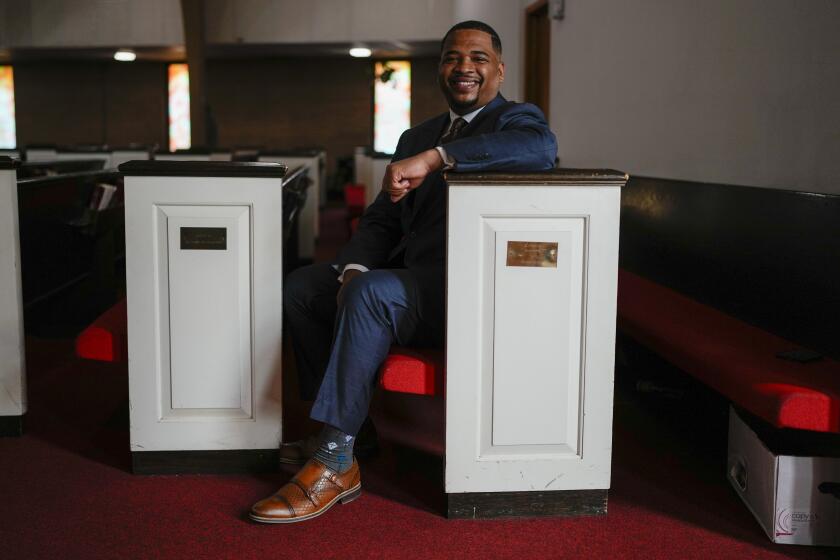Poisoned pair ask who targeted them and why
Yana Kovalevsky made a colorful entrance. Not long out of the hospital, she hobbled into her neighborhood Starbucks for an interview on a purple-and-pink-striped cane. A blond-and-brown-streaked wig roosted on her head.
Under the wig, her scalp was a patchy landscape. A traumatic shedding had left the locks that once cascaded to her elbows struggling to regrow.
She needed the cane because a nerve-pinging disorder that somehow combined pain and numbness had turned her legs to rubber.
Last February, during a visit to their native Russia, Kovalevsky, a 27-year-old North Hollywood social worker, and her physician mother became critically ill from the effects of thallium. Their ordeal made worldwide headlines because thallium is a rare poison usually associated with political assassins and murderous inheritance seekers, not with the likes of Yana and Dr. Marina Kovalevsky.
It remains unknown how they came to ingest the tiny but potentially lethal amounts of the heavy metal. Among the other unanswered questions is who targeted them and why -- if the poisoning was intentional, as mother, daughter and their doctors now believe.
The doctors express confidence about the long-term prognosis for the Kovalevskys’ physical health, although there are no guarantees. What does seem certain is that Yana, who got the worse of the poisoning, will have to remind herself not to look over her shoulder, as she tries to put her life back together.
“Either someone wanted us dead or somebody messed up,” said Yana, who five months ago was a UC Irvine graduate looking forward to law school.
“There is some person out there who is mad because he missed his chance.”
Russian exodus
A decade and a half before they were poisoned, the Kovalevskys had been an unheralded part of another international story -- the emigration of Soviet Jews. They had followed Marina’s brother Dr. Leon Peck, a fellow physician, to the United States. Peck had been a refusenik for 10 years before he received a visa to leave Russia in 1988. The Kovalevskys got out in 1991, settling in Los Angeles and then moving to Louisiana, where Marina, 50, completed a medical residency. They returned to California, where Marina established a family practice out of a West Hollywood storefront.
She is now back at work and has declined to be interviewed, pleading for privacy. Yana said her mother’s reticence hardened after FBI agents investigating the poisoning queried her about the Russian American medical community, which has been a focus of insurance fraud inquiries.
An FBI spokeswoman declined to comment.
“I don’t have any faith in them,” Yana said of the FBI agents. A family friend and attorney, Frank Capwell, echoed her comments: “The agents were talking to them about things that were tangentially related to the poisoning, and I mean tangentially at best. Yana’s mother is completely innocent of any wrongdoing.”
The Kovalevskys had gone to Moscow to attend a 50th birthday celebration for a close friend of Marina.
After the birthday party, they sampled the city’s museums, art shows and theaters. They were enjoying a stage musical when Yana got sick. “Stomach cramps,” she recalled. “I missed the end of the play.”
Their initial diagnosis was food poisoning, but in truth the thallium was beginning to take its toll.
In the past, thallium had been used in rat poison, until its toxicity to humans prompted most countries to ban it. One gram is enough to kill a person, and lesser amounts can damage the heart, brain, spinal cord and lungs, as well as just about every other part of the body.
Saddam Hussein used thallium to eliminate his opponents. And the metal was first suspected in last year’s fatal poisoning of former Russian spy Alexander Litvinenko in England. It turned out that he died from exposure to a radioactive isotope, polonium 210.
Yana felt well enough the next day to tour an art gallery and go to dinner. But then the cramping intensified, and the Kovalevskys called it a night. “My mom tried to put me to bed,” Yana said. “I had to go to the bathroom and I fell. I just started crying. I said, ‘I’m sorry, but I think we have to go to the hospital.’ ”
They took a taxi to an American clinic the hotel recommended.
“By the time we got to the hospital, my mom couldn’t walk,” Yana said. “They had to bring stretchers for us.... I was thinking, ‘What is wrong with me? Why can’t my mom help me?’ ”
Friend to the rescue
The hospital quickly placed the women on dialysis, but it would be several days before they identified thallium as the source of their agony. Yana had never heard of it and said her mother “didn’t really believe” the diagnosis at first.
But they became terrified all the same, especially since the doctors said they had no antidote in stock and did not know where they might find any.
The Kovalevskys called Peck, an oral surgeon, with a borrowed cellphone, and he set about searching for Prussian blue, a pigment that binds to microscopic fragments of metal and one of the few known antidotes to thallium poisoning.
“I found a guy in the FDA,” he said. “He told me about this company in Texas, and they gave me the number of this pharmacy in Santa Ana.”
The pharmacy had a batch on hand. Peck had a relative speed down to Orange County to buy $1,300 worth and was on the next plane to Moscow.
Peck gave it to the women himself. Overnight, they showed signs of improvement.
But the Russian authorities were not prepared to let them leave. A criminal investigation of the poisoning was underway, and the police had placed the women’s hotel room and passports off-limits.
Peck went to the police station to remonstrate. He said the officers would give him no information. Marina called him to say that several guards with machine guns had appeared outside the hospital room. Interrogators followed. Peck said an official told him that the women must stay while the investigation proceeded. “I said, ‘A criminal investigation is fine, but what if they die?’ ” he recounted.
Peck contacted the office of Rep. Brad Sherman (D-Sherman Oaks), and the congressman’s staff enlisted the U.S. Embassy in Moscow to issue emergency passports for the Kovalevskys. An embassy staffer went to the hospital to take their photographs.
Finally, the Russians relented and turned over the original passports. Peck booked a flight for the following day, buying his sister and niece three seats each, so they could lie down.
Next came the jarring scene at Los Angeles International Airport, where they were greeted in their wheelchairs by banks of television cameras. Until then, Yana said, she hadn’t quite grasped how perilous her situation had been.
“The media attention scared me more,” she said. “I thought, ‘This thallium must be really serious.’ ”
Peck checked the women into Cedars-Sinai Medical Center, where Marina is an attending physician, after determining that there was no hospital that specialized in treating thallium cases.
That figured. In 2005, the last year for which complete numbers are available, there were just 30 thallium poisonings in the U.S. -- all nonfatal and only one considered intentional, said Alvin Brownstein, an associate director of the American Assn. of Poison Control Centers.
But Yana’s neurologist at Cedars, Dr. Israel Gorinstein, who had to bone up on thallium, discovered that it was a more common instrument of death in the former Soviet Union.
“There is a lot of literature on that, most of it coming from Russia,” he said.
Celebrity patients
The Kovalevskys were admitted at Cedars under assumed names, for their protection. Yana and her mother were celebrity patients, however, given their one-in-a-million ailment.
Gorinstein said he fretted about their nervous systems and virtually every organ in their bodies. Yana was in particularly bad shape. She had 50% more thallium in her system than Marina did and suffered burning and tingling pain from the waist down, numbness elsewhere, a loss of balance, diarrhea and confusion. The only sure treatment is Prussian blue, which slowly removes metal through the bowels.
“It’s a long elimination process,” Gorinstein said. “I didn’t know how they would respond.”
But his own confidence grew as test results came back negative. MRI scans detected no brain damage. There were some blood abnormalities -- elevated white cell counts -- but they resolved themselves. The other vital functions seemed fine, and the pain began to ease.
After about 10 days at Cedars, Marina had rebounded enough to go home, but she stayed in the hospital to be with her daughter, Yana said. The two were discharged a few days later and convalesced at Marina’s Studio City home.
Gorinstein said he believes the prospects for a full recovery are good. And like the Kovalevskys, he has no doubt that the poisoning was deliberate.
Countless scenarios
Yana said she and her mother are certain they know where in Moscow they were poisoned, although lawyers have advised them not to publicly disclose it.
The more haunting questions come down to who might lurk behind the poisoning and why.
“We have no political ties, we have no property in Russia and I don’t have a boyfriend with mob ties,” Yana said.
Her mind has spun with countless other scenarios, none of them plausible or reassuring. She said Russian authorities have needlessly questioned family friends in their home country.
“We just want it over,” she added wearily. She has started a new job, as a part-time social worker for an adult day care center. Law school is on hold.
The bouts of fatigue haven’t ended. And it was only recently that she could abandon the cane and wigs. Friends had given her a collection in a variety of colors, including blue.
They also decorated her birthday cake with blue icing.
“And we had blue balloons,” Yana said. “My friends took the Prussian blue thing really far.”
More to Read
Start your day right
Sign up for Essential California for news, features and recommendations from the L.A. Times and beyond in your inbox six days a week.
You may occasionally receive promotional content from the Los Angeles Times.







